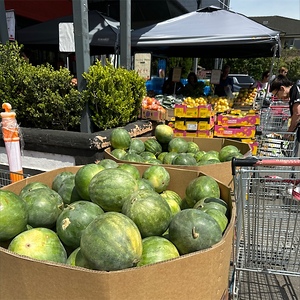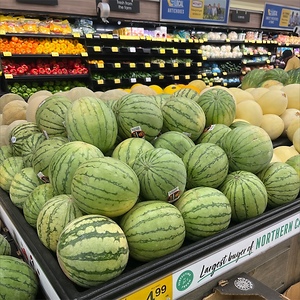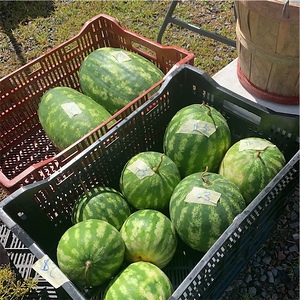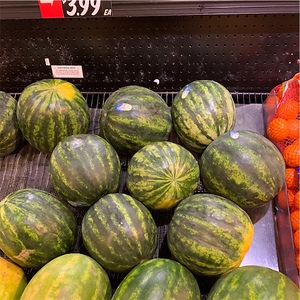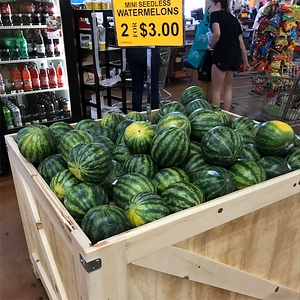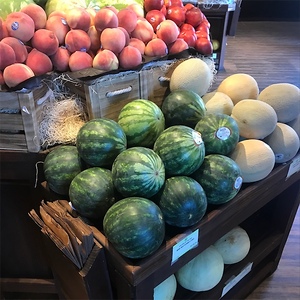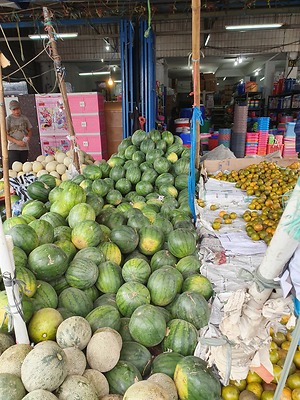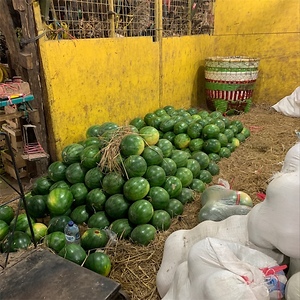

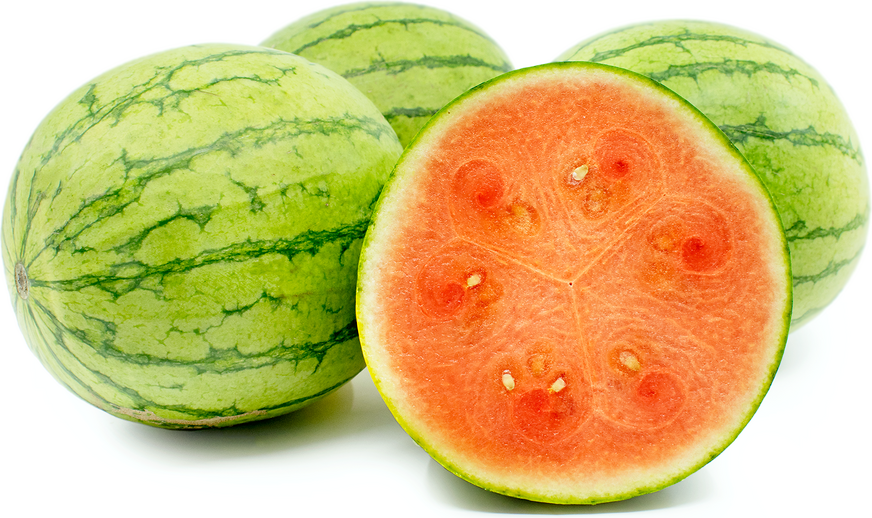
Personal Watermelons
Estimated Inventory, 6 lbs : 0
Description/Taste
Personal watermelons are a type of melon named for their convenient personal-sized portions. They are also referred to as mini watermelons, baby watermelons, or palm melons. They have an average diameter of 14 to 19 centimeters and weigh 48 to 118 ounces, making them much lighter than larger varieties of watermelon. Personal watermelons can have rinds in various colors, including green, yellow, and striped, variegated patterns that combine various shades of green and yellow. The rind is typically smooth and firm in texture, with thickness varying from 0.5 centimeters to 1.8 centimeters depending on the variety. The flesh can be dark red, pink-red, orange-red, or yellow and has a crisp, tender, and succulent consistency. Personal watermelons have a mildly sweet aroma and a refreshing yet slightly tangy taste. They typically have a notably sugary taste, though sweetness can vary based on the variety.
Seasons/Availability
The peak season for Personal watermelons is late summer, through fall. In some regions, they can be harvested in early winter.
Current Facts
The botanical name for Personal watermelons is Citrullus lanatus and they belong to the Cucurbitaceae family, which also includes squash, pumpkin, and zucchini. Personal watermelons are bred to be lighter, easier to store, and more convenient for solo eating and small-space gardening. The original watermelon species was small like the Personal watermelons but over time was bred to be larger. It wasn’t until the 20th century that breeders and consumers became more interested in smaller varieties like the Sugar Baby, Blacktail Mountain, Yellow Petite, Sweet Beauty, Little Darling, Mini Love, and Cream of Saskatchewan. Most Personal watermelons are designed to be seedless, though some may contain trace amounts of small white seeds. There are over fifty cultivated varieties of Personal watermelons and they make up about 8.5% of watermelon production in the United States.
Nutritional Value
Watermelons contain vitamins C and B6, nutrients that may help with immune support, collagen production, brain function, protein metabolism, and mood regulation. Watermelons contain carotenoids, lycopene, and cucurbitacin E. These compounds can support eye, skin, and liver health as well as lower cholesterol, reduce blood pressure, prevent tumor growth, and decrease inflammation. They can help combat free radicals that may damage cells and lead to conditions like heart disease, diabetes, and prostate and colorectal cancer. Like many watermelon varieties, Personal watermelon is known for its hydrating properties, comprised of nearly 90 percent water. Watermelons contain fiber, which may improve digestion and increase feelings of fullness, and citrulline, a nutrient that may help reduce muscle soreness.
Applications
Personal watermelons are usually eaten raw, but may also be juiced, frozen, grilled, or seared. They can be used interchangeably with other varieties of watermelon. Personal watermelons’ small size makes them convenient for slicing and eating fresh. Once the flesh is removed, the halved melons are the ideal serving size for individual bowls to hold cold soup, salads, ice cream, and sorbet. Pureed Personal watermelons can be used to make pies, cheesecakes, sauces, dips, and cocktails. Diced or sliced, they can be used in green salads, curries, flatbreads, fruit salads, or on crudité platters. Though the rind isn’t edible raw, it can be pickled. Personal watermelons are complemented by the flavors of arugula, mint, basil, cilantro, feta cheese, mozzarella, avocado, onion, mushrooms, beef, pork, cranberries, dried coconut, toasted pecans, pistachios, cherries, blackberries, pomegranate, lime, lemon, orange, and balsamic vinegar. Uncut Personal watermelons will keep refrigerated for up to two weeks after being harvested.
Ethnic/Cultural Info
Countries across the globe have taken an interest in developing Personal watermelons. In Tawaiin, a gardener named Chen Wen-yu developed a variety called Yellow Baby Watermelon in the mid-1900s. This variety was created by mixing an American Midget melon with a Chinese melon. This yellow-fleshed variety arrived in the United States in the 1970s and remains one of the more prevalent Personal watermelons today. Known as the Watermelon King, Weny-yu had developed one-fourth of the world’s watermelon seeds and 280 varieties by the time he died in 2012.
Geography/History
Watermelons are native to Africa and were introduced to North America by European settlers and the African slave trade. Though the origins of Personal watermelons aren’t widely known, they began to be cultivated and studied on a larger scale by the University of California in the early 21st Century and became widely available by 2003. They are now majorly produced in California, Arizona, New Mexico, and Mexico. Personal watermelons thrive in warm, arid regions with temperatures ranging from 70 to 80 degrees. As a cultivated variety, they do not grow in the wild but are produced by home gardeners and commercial farms. Personal Watermelons grew in popularity due to their small and ease of growth in small spaces. Though commercial farmers increasingly grow Personal watermelons, this variety is not nearly as popular as larger varieties. They are more likely to be found in specialty stores, farmers’ markets, and home gardens rather than larger grocery stores.
Recipe Ideas
Recipes that include Personal Watermelons. One



